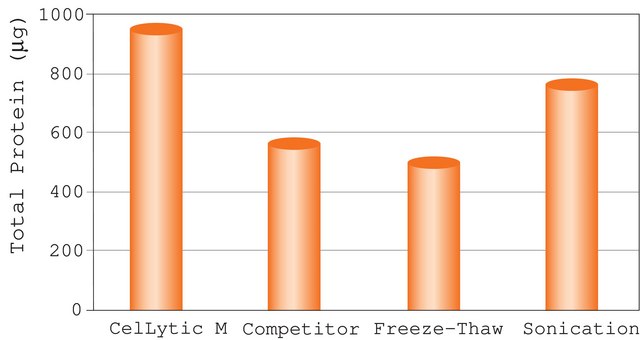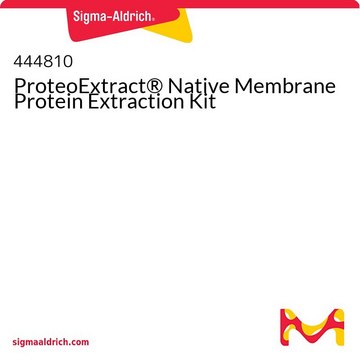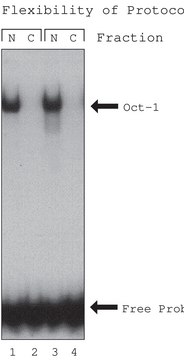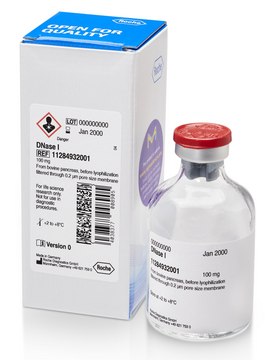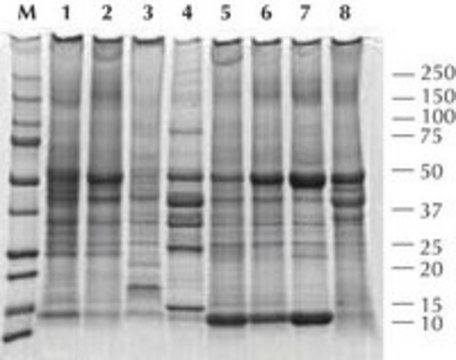CE0050
CelLytic™ MEM Protein Extraction Kit
Synonym(s):
Membrane protein extraction kit
Sign Into View Organizational & Contract Pricing
All Photos(1)
About This Item
UNSPSC Code:
41116134
NACRES:
NA.56
Recommended Products
General description
CelLytic™ MEM Protein Extraction Kit offers a fast and convenient method to isolate hydrophobic and raft microdomain associated proteins from cells. The method is based on phase separation and does not require cell membrane isolation. The separated proteins can be used for further experiments such as SDS-PAGE, Western blotting, dot blotting, and immunoprecipitation. The kit has been tested on, but not limited to, HeLa, HEK-293, NIH 3T3, COS and CHO cell lines.
Membrane proteins make up around 20-30% of an organism′s genome and serve as cellular gatekeepers, regulators, and sensors. They have diverse cellular functions, such as shielding the cell from external toxins, being the starting point of intracellular signaling cascades, and retaining critical ion concentrations.
Application
CelLytic™ MEM Protein Extraction Kit has been used for de novo lipogenesis measurements using hepatocytes and to extract membrane proteins for western blotting.
Suitability
Sufficient reagents supplied for 80 tests.
Legal Information
CelLytic is a trademark of Sigma-Aldrich Co. LLC
Kit Components Only
Product No.
Description
- Lysis and Separation Buffer 50 mL
- Wash Buffer for CelLytic MEM 50 mL
- Sodium Chloride, 4M Solution 1.5 mL
Kit Components Also Available Separately
Product No.
Description
SDS
- P8340Protease Inhibitor Cocktail, for use with mammalian cell and tissue extracts, DMSO solution 1 mLSDS
Signal Word
Warning
Hazard Statements
Precautionary Statements
Hazard Classifications
Eye Irrit. 2 - Skin Irrit. 2
Storage Class Code
10 - Combustible liquids
Flash Point(F)
188.6 °F - closed cup
Flash Point(C)
87 °C - closed cup
Regulatory Information
常规特殊物品
Choose from one of the most recent versions:
Certificates of Analysis (COA)
Lot/Batch Number
Don't see the Right Version?
If you require a particular version, you can look up a specific certificate by the Lot or Batch number.
Already Own This Product?
Find documentation for the products that you have recently purchased in the Document Library.
Hiroaki Tateno et al.
Glycobiology, 26(12), 1328-1337 (2016-04-03)
Human somatic stem cells such as human mesenchymal stem cells (hMSCs) are considered attractive cell sources for stem cell-based therapy. However, quality control issues have been raised concerning their safety and efficacy. Here we used lectin microarray technology to identify
Sushmitha Vijaya Kumar et al.
Scientific reports, 10(1), 14985-14985 (2020-09-13)
Membrane organization plays an important role in signaling, transport, and defense. In eukaryotes, the stability, organization, and function of membrane proteins are influenced by certain lipids and sterols, such as cholesterol. Bacteria lack cholesterol, but carotenoids and hopanoids are predicted
Willy Morelle et al.
The Journal of clinical endocrinology and metabolism, 102(4), 1375-1386 (2017-03-23)
TMEM165 deficiency is a severe multisystem disease that manifests with metabolic, endocrine, and skeletal involvement. It leads to one type of congenital disorders of glycosylation (CDG), a rapidly growing group of inherited diseases in which the glycosylation process is altered.
Tomoaki Furuta et al.
Cancer science, 112(9), 3722-3731 (2021-06-12)
The rBC2LCN lectin, known as a stem cell marker probe that binds to an H type 3 fucosylated trisaccharide motif, was recently revealed to also bind to pancreatic ductal adenocarcinoma (PDAC) cells. A lectin-drug conjugate was generated by fusing rBC2LCN
Elisabeth P Carpenter et al.
Current opinion in structural biology, 18(5), 581-586 (2008-08-05)
Membrane protein structural biology is still a largely unconquered area, given that approximately 25% of all proteins are membrane proteins and yet less than 150 unique structures are available. Membrane proteins have proven to be difficult to study owing to
Our team of scientists has experience in all areas of research including Life Science, Material Science, Chemical Synthesis, Chromatography, Analytical and many others.
Contact Technical Service